The Flatirons.com
A very rough 16 days on the road
Over the last 30 years I have been fortunate enough to see several lifetimes worth of wilderness and natural places. My first two decades averaged 10 to 30 miles a week of pure hikng. I have been fortunate to have as a climbing partner, a high energy outdoorsman that will try to climb any ridge-line close enough to get on. Over the years I have been subject to extreme hikes with no certain destination, variable weather that can leave a guy stranded on high ridges exposed and difficult circumstances that can lead to outdoor adventures that most people try to avoid.
When I think of all those experiences, I find myself asking how 16 days of any kind could be worth whining about. I really believe it has to do with my mental and physical states and what the demands of a trip force on me. For many people, a wilderness experience is usually thought of as relaxing, kind of a vacation. For most landscape photographers this is not the case. If the setting is new to me, it requires that I observe constantly and learn how best to approach the land and capture the light that hits it. This almost always requires being up before dawn, and at attention for every sunset. No matter how bad my feet hurt or how much I want to be in the local hot springs.
Feet hurt? Are you kidding, you may ask. Yes, I have feet that were made for city life. Within hours of starting a hike, I usually develop hot spots that can turn my feet into blisters within minutes. And not just a few, the average is 10 to 20 blisters on any given hike. This has caused me to take preventive measures that do not always provide predictable results. But so what. I usually just hike through the malfunction and pick up the pieces when I get home. By Thursday I can usually be talked into planning the next weekend. However I graduated from being a weekend warrior a long time ago. My work can take me out in the field at any given time and for any duration of time. Fortunately I have a very understanding wife.
I do not mean to complain at all. In fact I am the one that chooses this lifestyle. The return on investment is immeasurable so these are easy decisions. Never mind the fact that I could never turn my back on the natural world. This IS my destiny. And I love it. This is where I belong. So what was so hard?
Well it started on the first morning as I was getting ready to leave. For the first trip which lasted 5 days, I included my neighbor who is always eager to get out but often times not prepared or ready on time. This was the case that morning as I had the car completely packed and ready to go, but he was nowhere in sight. So I waited. I don't mind waiting on people, but I do mind when someone does not respect my time as it is my most valuable resource. Eventually he showed up and we left.
Our destination was Green River Lakes, the headwaters to the Green river and a spectacular natural area located in the Wind River range of Wyoming. This valley has all the hallmarks of a national park with almost no regulations. That can be both good and bad. But the fact remains that places like this are getting harder and harder to find. And once again we were able to secure the best camping spot in the valley. And what a valley it is. On any given day you are likely to see coyote, bears (both black and grizzly) bald eagles, deer, moose and even wolves, on this occasion we saw hawks every mile. This valley is connected to the greater Yellowstone ecosystem and contains an abundance of wildlife.
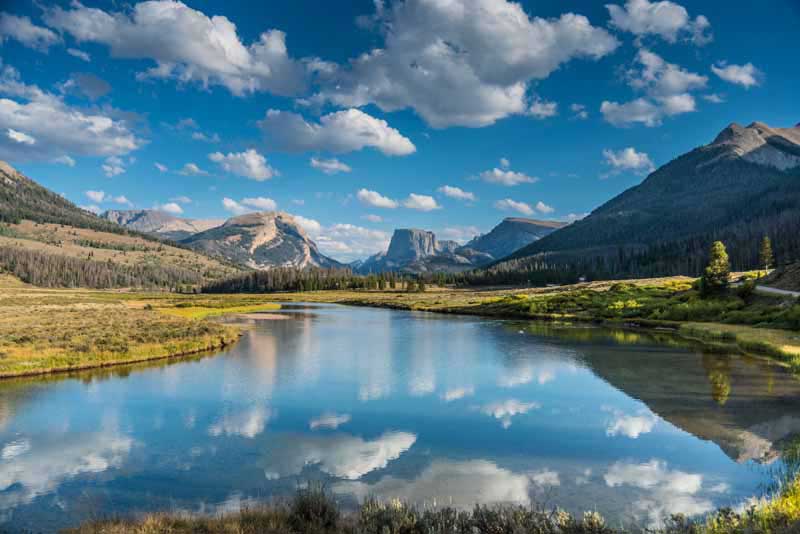
The Wind Rivers at Green River Lakes. The view from camp looking east towards Flattop Mountain.
This space is much bigger than a person might think as they look over the valley and try to estimate it's size. Although I was aware of this, it still caused the hikes to stretch out to bigger distances than planned. And that is not a good thing for old blistered feet. On that particular morning I made a bad decision. A very bad decision. I did not pack my hiking socks and instead had to rely on standard wool socks that seem okay but led to big time trouble. A short hike around two lakes and 10 miles later I have 14 to 20 blisters and some of them are deeper than initially realized. Thankfully they did not come up until I was back at camp, but after 30 years experience with this condition, I know how bad it is. By the way, bad feet run in my family. My nephew suffered through marine boot camp and almost required surgery to correct his condition. I hear about it all the time from my extended family that so and so inherited my feet. Which I am sorry to hear about. Such is life.
So day one of a 16 day experience and I am basically crippled. No more 10 mile hikes in this valley on this trip. Instead I take short hikes and car trips looking for wildlife. Within minutes I am seeing hawks, eagles, coyotes, swans and small woodland creatures. This place is great. I am averaging a new hawk every mile of so. I still walk several miles but I do not allow myself to get so far away from camp that problems could arise. My neighbor hikes the next day alone. This valley is so big that all we can do is explore by day hiking. The valley leading up to timberline and the high mountains would require a 17 mile hike just to get into the mountain passes. Never mind about hiking back. I have backpacked the higher areas outside of this valley and they are of the highest quality I have seen. But I know that requires a dedicated trip designed to travel greater distances and carry everything I would need. I have never liked horse back riding and so I never use them (but that may change). Although if ever there was a place to consider it, this would be it.
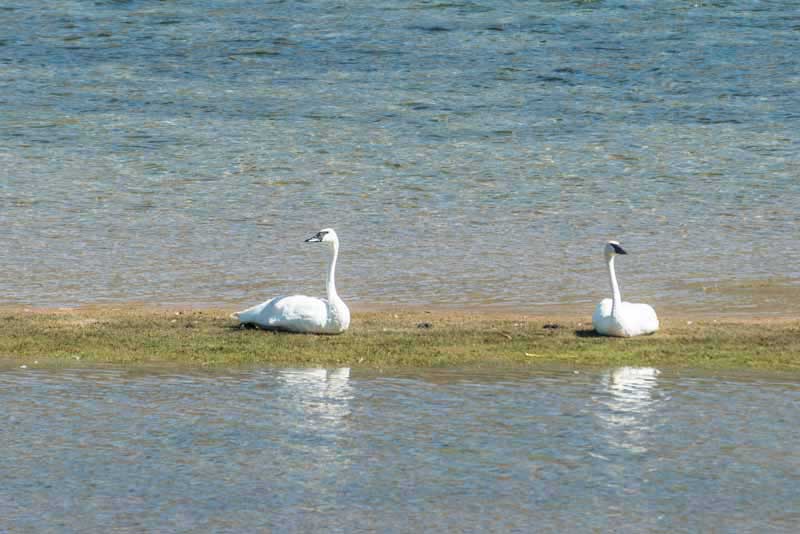
The Wind Rivers at Green River Lakes. A pair of mating swans.
By day three I am fishing in sandals just to get my feet wet and soften up the blisters. Works for a short while. Fortunately we have a visit to the local hot springs scheduled and I am able to evaluate my situation and try to understand the impact on the next trip, which starts one day after getting back home. The hot springs are located deep in the Gros Ventre (pronounced grow vant) range and offers exceptional scenery while sitting in hot cement pool. Oddly enough things looked like they were healing up. The ride home takes us through Grand Teton National Park and as dawn arrives, I find the entire valley in thick smoke. Fires from Idaho have settled into the valley and filled it so that no photographic opportunities other than thick, smoke filled landscapes are possible. I took 20 images and then we left. I still can't believe how bad it was.
At home I was able to apply some first aid and my feet began to heal. As I mentioned this usually take the better part of four to five days and things turn around. But on this occasion that was not the case. These wounds were deep and took almost two weeks to heal up. The next trip was a two day excursion to Lake Powell, Utah from my home in Boulder, CO. What is better is this trip involved flying over Colorado and Utah in a small 6 seater Cessna plane. Although the same smog present in Grand Teton was also down here, it was not nearly as bad. The trip was two days of pure fun, sandwiched between unbelievable scenery captured in 706 images. I have studied the features of the Western U.S. Extensively and it was pure bliss to fly over all of these features that I have spent so much time hiking through. As soon as we arrived at Lake Powell, we jumped in a speed boat and cruised into the side canyons of Lake Powell. Again we had wonderful landscapes to shoot and an opportunity for my feet to heal up.
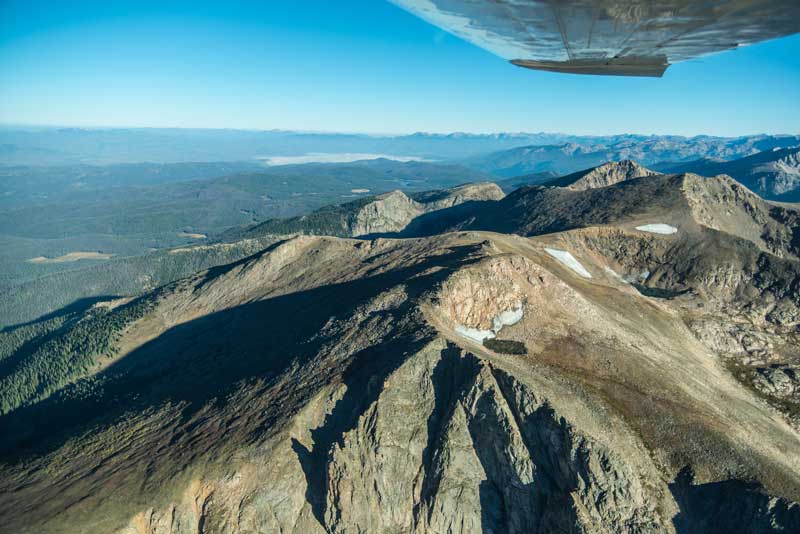
Crossing the continental divide, leaving Boulder on the way to Lake Powell.
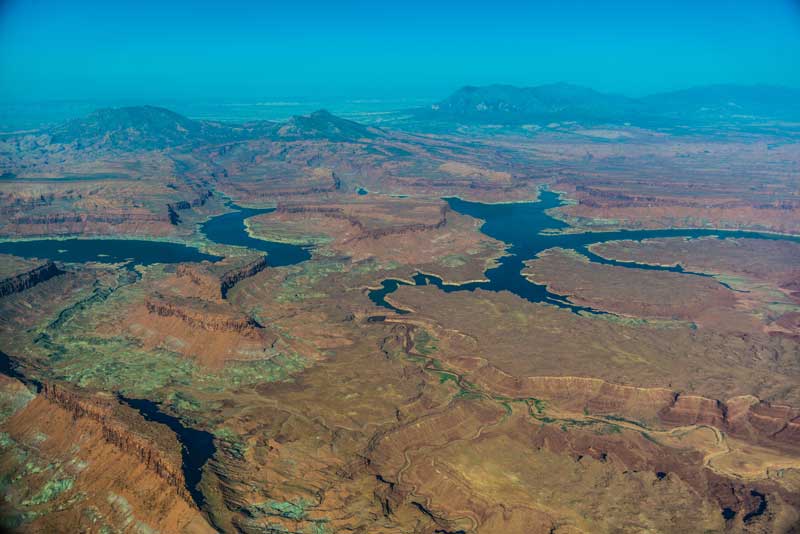
Coming into Bull Frog on Lake Powell.
As happy hour arrived that night,I found myself out hiking to try and capture the mood of a small sandstone formation just outside of our rented, double wide trailer. As I hiked through the sand washes, I quickly found myself surrounded by cryptobiotic soils, which mean I could not go farther. Cryptobiotic soils are very fragile microbial communities found in desert sands. These communities serve to hold soil in place and stop wind erosion. They take decades to establish and hiking on them is unacceptable. So I took a few images and headed back to a margarita. But that little reconnaissance mission showed me the trail I would hike the next morning with my wife and friends. The hike was so refreshing that I never even thought about my feet which were still suffering greatly from the last week.
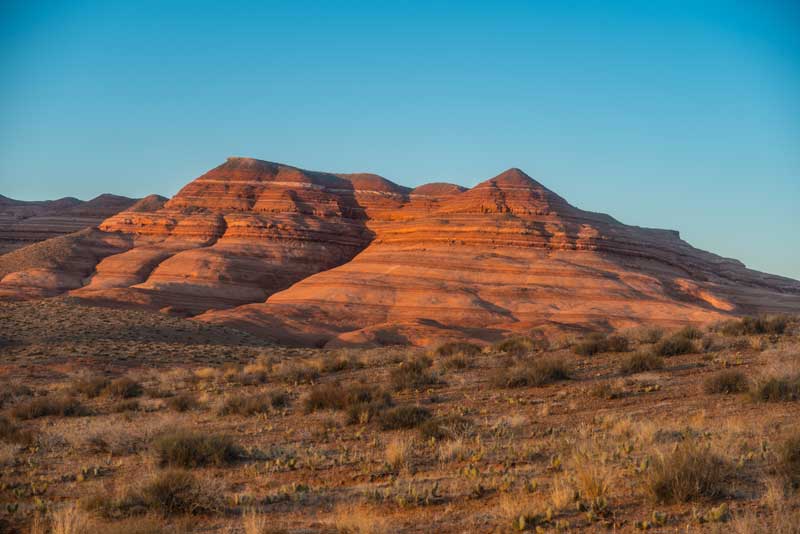
A small sandstone formation outside of our double wide trailer.
Through the entire round of pain I kept telling myself to focus on the work at hand and forget about my personal condition. I figured that if I did that I might be rewarded with a very satisfying feeling of accomplishment and some fine images to show for it. The morning shoot was great. The land forms were bathed in a soft light and the hiking was gentle while providing excellent views into the surrounding landscape. By this time I could walk without limping. But my body was not out of trouble by any means yet. While still in the Wind River range I noticed a deep pain immediately below my right eye. A deep sty was developing and would take days to emerge. But the pain was there days before any noticeable sign appeared.
When we got back to Boulder, I spent one night nursing my feet back to health and trying to get them ready for what awaited them next, a 30 mile hike through the Collegiate range in central Colorado. This is the highest range in the state and starts out with a nine mile hike and a gain of 2,300 vertical feet. But this time, I had a full arsenal of socks, liners and protection. One night of soaking, moisturizing and manicuring and I was feeling confident in my ability to complete this last trip. We had many miles to hike but we did not have to carry a full set of backpacks. For this trip we rented four llamas for three people. Each llama can pack upwards of 100 pounds if one is careful, so all I had to pack was my camera equipment, tripod and lunch.
My feet were still torn up but now manageable. I choose expedition quality socks that were so thick they mostly kept my feet off of the bottom of my boots. At least it felt that way. By using different types of socks, liners, sandals, boots and tennis shoes, I was able to hike everything and capture fall colors in what turned out to be a very beautiful trip. But now my eye had turned into a huge, puffy mass, that made people wonder if I had just got out of a fight. Within days it got so bad I had to put a hot compress on it and allow it to drain out. Fortunately I shoot with my other eye so I could still photograph, otherwise it would have been impossible.
The mountains received snow the day before we arrived which cooled things down considerably. The big drought and most of the western states were dried out and crackly underfoot. Autumn colors were a week early and it sure seems like the drought brought the colors on early. The images on this trip certainly show a disparity between the beautiful foliage of the yellowing aspen and the drought stricken shrubbery. I can easily tell the difference between images from this year and normal years.
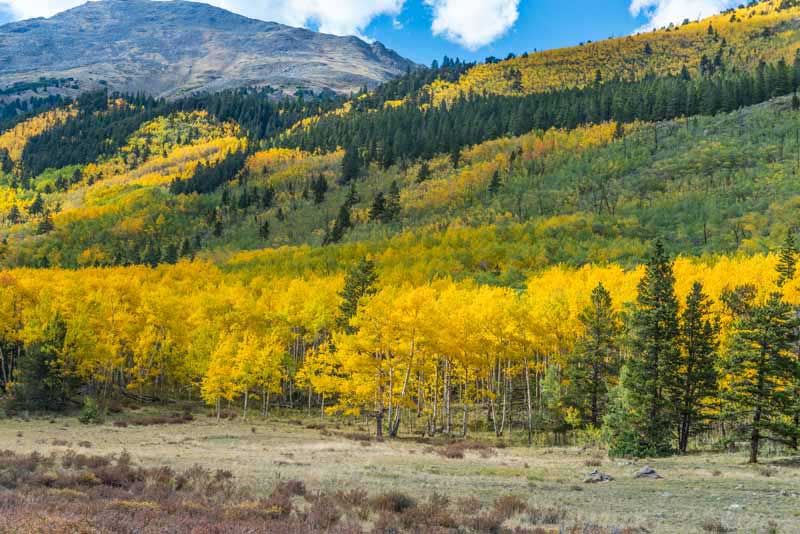
A typical shot up Pine Creek drainage in the fall of 2012. Notice how dry the shubbery is.
After five days of hiking, the morning broke cloudy and cold. We were leaving this day and I awoke to shoot dawn only to find overcast skies, threatening conditions and an occasional snow flake. I had my tent and camp packed up before the other guys got out of their sleeping bags. A few quick images and my attention turned to getting out before the rain or snow started. That was not to be. Within minutes flakes started to fall which then briefly turned to rain before turning once again to snow. The llamas were intensely interested in packing down the trail as they seemed to smell the barn. Holding them back so they did not overtake us, was requiring new skills. The trail out is quite steep and slippery under foot when rain and snow combine. A steep hillside was present most of the way down and extra care had to be used to keep the pack animals away from the edge or pushing us over it.
Of course I developed new hot spots and some new blisters on this hike, but after a while I began to forget about it. By the time we got out, my feet were finally healing up for the most part. And I was beginning to feel like my old self. My eye was noticeably better and the snow seemed to bring me new energy. Finally after a very hot summer, we were now getting some cooler temperatures. A quick nine miles of early morning hiking and we were back at the car, loading up the llamas. The 16 days were over, I survived and actually had a great time. I just hope I learned something.